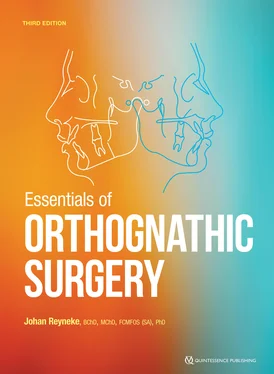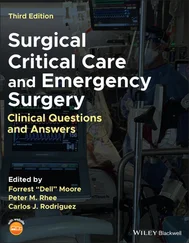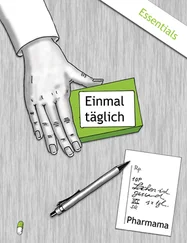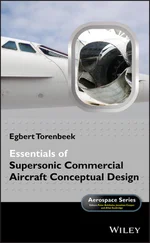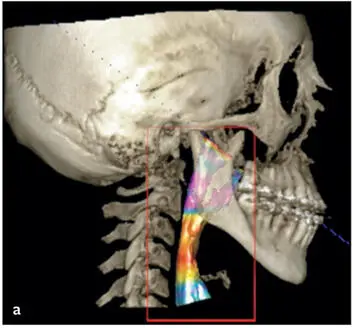
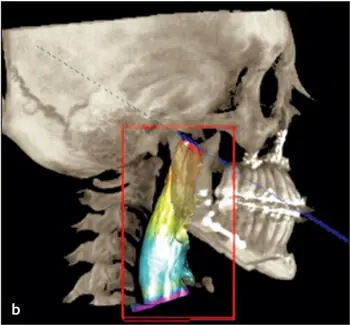
Fig 2-85Patients with high mandibular plane angle Class III occlusion treated with counterclockwise rotation of the maxillomandibular and advancements benefit because the D-point moves upward and forward, the incisors move backward, and the airway is enhanced. Presurgical (a) and postsurgical (b) CBCT scans demonstrate the advantage of this approach (red rectangles) .
Orthognathic surgery can impact the airway whether or not a patient has OSA, so the changes in the airway must be carefully considered during treatment planning.
Conclusion
Generations of surgeons have focused mainly on the original three pillars of orthognathic surgery treatment planning: dental decompensation and stability, skeletal correction and stability, and a pleasing esthetic outcome. Now there is a fourth pillar of treatment planning: providing skeletal support of the airway and surgical movements that enhance the airway or at least mitigate any deleterious effects.
Recommended Reading
Abramson Z, Susarla SM, Lawler M, Bouchard C, Troulis M, Kaban LB. Three-dimensional computed tomographic airway analysis of patients with obstructive sleep apnea treated by maxillomandibular advancement. J Oral Maxillofac Surg 2011;69:677–686.
Ackerman JL, Proffit WR. The characteristics of malocclusion: A modern approach to classification and diagnosis. Am J Orthod 1969;56:443–454.
Aquilino SA, Matteson SR, Holland GA, Phillips C. Evaluation of condylar position from temporomandibular joint radiographs. J Prosthet Dent 1985;53:88–97.
Arnett GW, Bergman RT. Facial keys to orthodontic diagnosis and treatment planning, Part I. Am J Orthod Dentofacial Orthop 1993;103:299–312.
Arnett GW, Bergman RT. Facial keys to orthodontic diagnosis and treatment planning, Part II. Am J Orthod Dentofacial Orthop 1993;103:395–411.
Barbosa AL, Marcantonio E, Barbosa CE, Gabrielli MF, Gabrielli MA. Psychological evaluation of patients scheduled for orthognathic surgery. J Nihon Univ Sch Dent 1993;35:1–9.
Becker OE, Avelar RL, Göelzer JG, Dolzan Ado N, Haas OL Jr, De Oliveira RB. Pharyngeal airway changes in Class III patients treated with double jaw orthognathic surgery—Maxillary advancement and mandibular setback. J Oral Maxillofac Surg 2012;70:e639–e647.
Burstone CJ, James RB, Legan H, Murphy GA, Norton LA. Cephalometrics for orthognathic surgery. J Oral Surg 1978;36:269–277.
Burstone CJ. Lip posture and its significance in treatment planning. Am J Orthod 1967;53:262–284.
Burton PR, Tobin MD, Hopper JL. Key concepts in genetic epidemiology. Lancet 2005;366:941–951.
Bütow KW, van der Walt PJ. The “Stellenbosch”—Triangle analysis of posteroanterior and basilar cephalograms. J Dent Assoc S Afr 1981;36:461–467.
Bütow KW, van der Walt PJ. The use of the triangle analysis for cephalometric analysis in three dimensions. J Maxillofac Surg 1984;12:62–70.
Butterfield KJ, Marks PL, McLean L, Newton J. Linear and volumetric airway changes after maxillomandibular advancement for obstructive sleep apnea. J Oral Maxillofac Surg 2015;73:1133–1142.
Czarnecki ST, Nanda RS, Currier GF. Perceptions of a balanced facial profile. Am J Orthod Dentofacial Orthop 1993;104:180–187.
Downs WB. Analysis of the dentofacial profile. Angle Orthod 1956; 26(4):191–211.
Dervis E, Tuncer E. Long-term evaluation of temporomandibular disorders in patients undergoing orthognathic surgery compared wit a control group. Oral Surg Oral Med Oral Pathol Oral Radiol Endod 2002;94:554-560.
Ellis E 3rd, McNamara JA Jr. Cephalometric reference planes—Sella nasion vs Frankfort horizontal. Int J Adult Orthodon Orthognath Surg 1988;3:81–87.
Epker BN, Fish LC. Dentofacial Deformities: Integrated Orthodontic and Surgical Correction, vol 1. St Louis: Mosby, 1986.
Epker BN, Stella JP. Systematic aesthetic evaluation of the neck for cosmetic surgery. Atlas Oral Maxillofac Surg Clin North Am 1990;2(3):217.
Epker BN. Evaluation of the face. In: Fonesca RJ, Marciani RD, Turvey TA (eds). Oral and Maxillofacial Surgery, vol 3, ed 2. Philadelphia: Saunders, 2009:1–57.
Fishman LS. Radiographic evaluation of skeletal maturation. A clinically oriented method based on hand-wrist films. Angle Orthod 1982;52:82–112.
Frost DE. Database collection for orthognathic surgery. In: Peterson LJ (ed). Principles of Oral and Maxillofacial Surgery, vol 3. Philadelphia: Lippincott, 1992:1279–1305.
Garvill J, Garvill H, Kahnberg KE, Lundgren S. Psychological factors in orthognathic surgery. J Craniomaxillofac Surg 1992;20:28–33.
Grave KC, Brown T. Skeletal ossification of the adolescent growth spurt. Am J Orthod 1976;69:611–619.
Greulich WW, Pylers I. Radiographic Atlas of Skeletal Development of the Hand and Wrist, ed 2. Stanford, CA: Stanford UP, 1959.
Hart PS, McIntyre BP, Kadioglu O, et al. Postsurgical volumetric airway changes in 2-jaw orthognathic surgery patients. Am J Orthod Dentofacial Orthop 2015;147:536–546.
Henzi A. Effects of different orthognathic surgery procedures on pharyngeal airway space: A single center study [thesis]. Zurich: University of Zurich, 2012.
Hernández-Alfaro F, Guijarro-Martínez R, Mareque-Bueno J. Effect of mono- and bimaxillary advancement on pharyngeal airway volume: Cone-beam computed tomography evaluation. J Oral Maxillofac Surg 2011;69:e395–e400.
Holdaway RA. A soft tissue cephalometric analysis and its use in orthodontic treatment planning. Part I. Am J Orthod 1983;84:1–28.
Holdaway RA. A soft tissue cephalometric analysis and its use in orthodontic treatment planning. Part II. Am J Orthod 1984;85:279–293.
Hulsey CM. An esthetic evaluation of lip-teeth relationships present in the smile. Am J Orthod 1970;57:132–144.
Jacobson A. The “Wits” appraisal of jaw disharmony. Am J Orthod 1975;67:125–138.
Kennedy B. Systematic aesthetic evaluation of the eyes and periorbital area for cosmetic surgery. Atlas Oral Maxillofac Surg Clin North Am 1990;2(2):393.
Kiyak HA, Hohl T, Sherrick P, West RA, McNeill RW, Bucher F. Sex differences in motives for and outcomes of orthognathic surgery. J Oral Surg 1981;39:757–764.
Kiyak HA, Vitaliano PP, Crinean J. Patient’s expectations as predictors of orthognathic surgery outcomes. Health Psychol 1988;7:251–268.
Laskin JL. Clinical history and physical examination. In: Laskin DM (ed). Oral and Maxillofacial Surgery, vol 1. St Louis: Mosby, 1980:399.
Legan HL, Burstone CJ. Soft tissue cephalometric analysis for orthognathic surgery. J Oral Surg 1980;38:744–751.
Li KK, Riley RW, Powell NB, Guilleminault C. Patient’s perception of the facial appearance after maxillomandibular advancement for obstructive sleep apnea syndrome. J Oral Maxillofac Surg 2001;59:377–380.
Lindhe J. Textbook of Clinical Periodontology. Copenhagen: Munksgaard, 1983.
McNamara JA Jr. A method of cephalometric evaluation. Am J Orthod 1984;86:449–469.
McNamara JB, Brudon WL. Orthodontic and Orthopedic Treatment in the Mixed Dentition. Ann Arbor, MI: Needham, 1993.
Merrifield LL. The profile line as an aid in critically evaluating facial esthetics. Am J Orthod 1966;52:804–822.
O’Ryan F, Schendel SA, Carlotti AE Jr. Nasolabial esthetics and maxillary surgery. In: Bell WH (ed). Modern Practice in Orthognathic and Reconstructive Surgery, vol 1. Philadelphia: Saunders, 1992: 284–317.
Читать дальше
